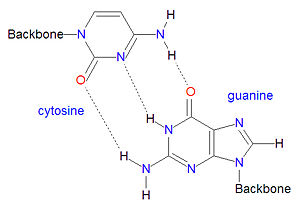Guanine: Difference between revisions
Jump to navigation
Jump to search

imported>David E. Volk (New page: {{subpages}} {{Chem infobox |align=right |image=center|200px|thumb|{{#ifexist:Template:Guanine.jpg/credit|{{Guanine.jpg/credit}}<br/>|}} |width=200px |molname=guani...) |
imported>David E. Volk m (wikilinks) |
||
| (4 intermediate revisions by the same user not shown) | |||
| Line 15: | Line 15: | ||
|casnumber= | |casnumber= | ||
}} | }} | ||
'''Guanine''' is a natural biomolecule used as one of the five bases in [[RNA]] and [[DNA]]. It is incorporated into these [[nucleic acid]]s in the form of [[guanosine]], a chemical compound formed by the combination of guanine and a [[ribose sugar]]. Guanine is also naturally present in phosphorylated forms of [[guanosine]]. | |||
== Basepairs == | |||
[[Image:Guanosine-cytodine basepair.jpg|left|thumb|300px|{{#ifexist:Template:Guanosine-cytodine basepair.jpg/credit|{{Guanosine-cytodine basepair.jpg/credit}}<br/>|}}]] | |||
Guanine and [[cytosine]] form a very stable Watson-Crick [[base pair]] containing three [[hydrogen bond]]s. | |||
Latest revision as of 18:26, 8 April 2009
|
| |||||||
| guanine | |||||||
| |||||||
| Uses: | |||||||
| Properties: | DNA/RNA base | ||||||
| Hazards: | |||||||
| |||||||
Guanine is a natural biomolecule used as one of the five bases in RNA and DNA. It is incorporated into these nucleic acids in the form of guanosine, a chemical compound formed by the combination of guanine and a ribose sugar. Guanine is also naturally present in phosphorylated forms of guanosine.
Basepairs
Guanine and cytosine form a very stable Watson-Crick base pair containing three hydrogen bonds.

